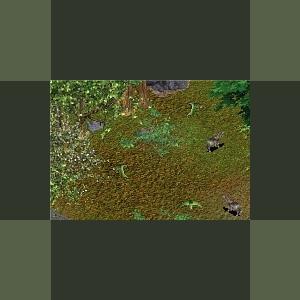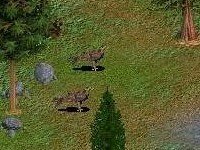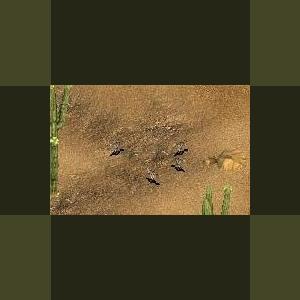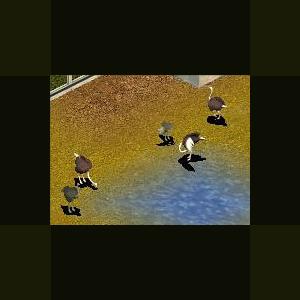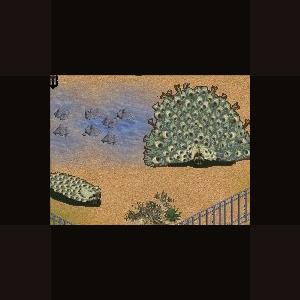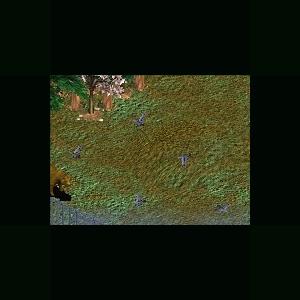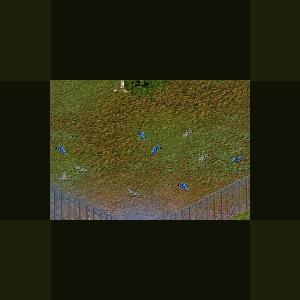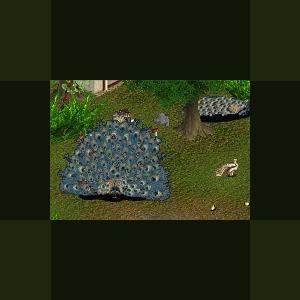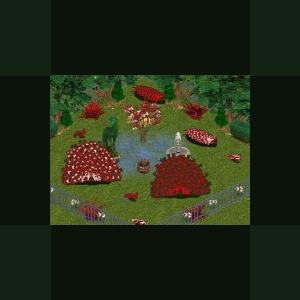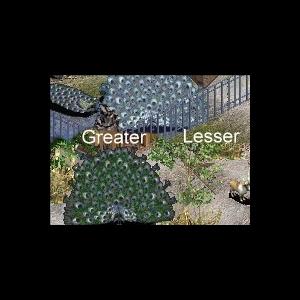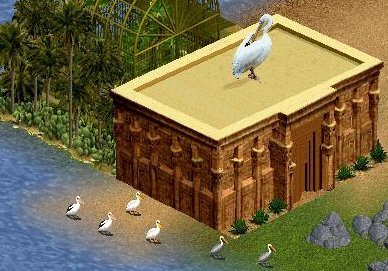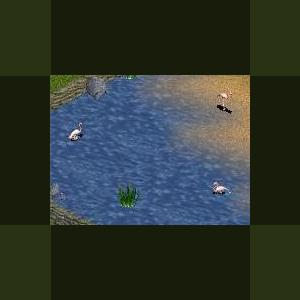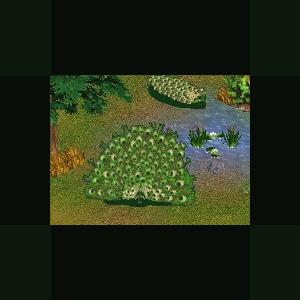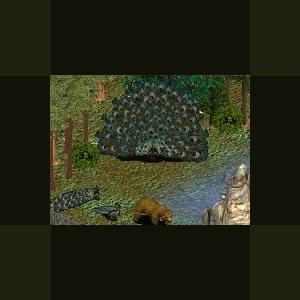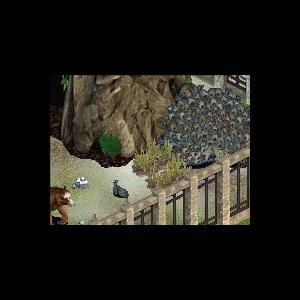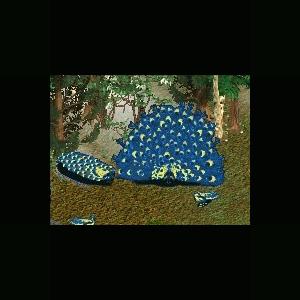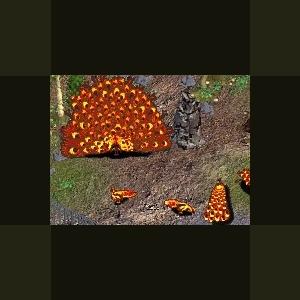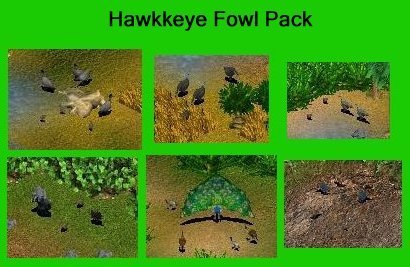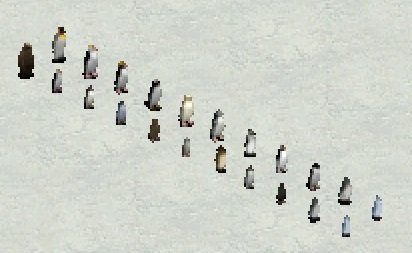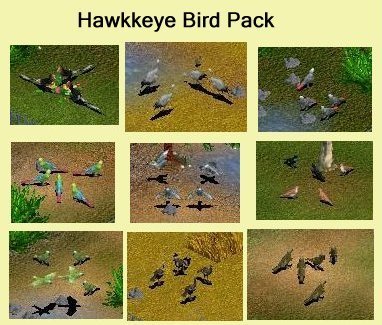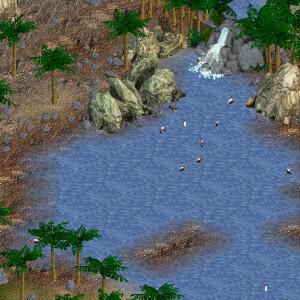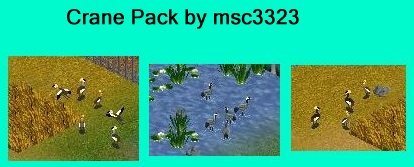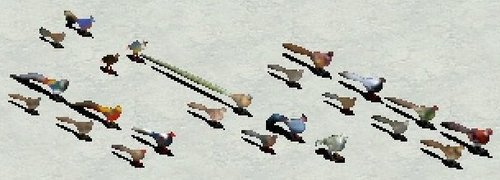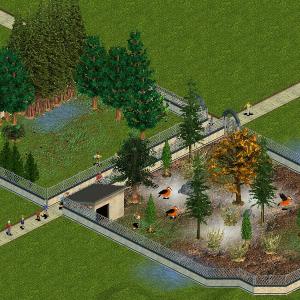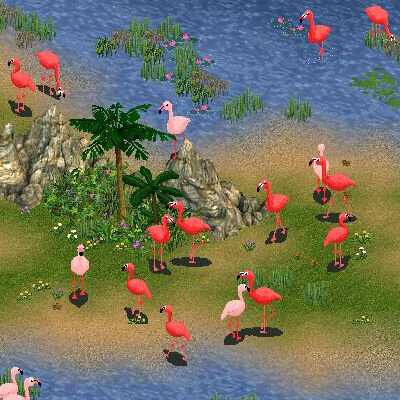Birds
Creatures on the wing
65 files
-
Red Crowned Parrot by Genkicoll
By Guest
The Red-crowned Amazon, (Amazona viridigenalis) also known as Red-crowned Parrot, Green-cheeked Amazon, or Mexican Red-headed Parrot, is an endangered Amazon parrot native to northeastern Mexico. The current native wild population of between 1,000 and 2,000 is decreasing. The main threats to its survival are the illegal export of trapped birds from Mexico to the United States and the destruction of habitat.
Description
Their appearance is generally green with the most notable features being a bright red forehead and crown, dark blue streaks behind the eyes, and light green cheeks.
Range
Their natural range is across the lowlands of northeastern Mexico. Feral birds have been introduced to urban communities of southern California and southern Florida. Birds in the Rio Grande Valley of Texas may be either feral or vagrants from Mexico.
Behaviour
They gather in large flocks being noisiest in the morning and evening. The characteristic screeching heard of these birds usually occurs when they travel in a large flock to a new feeding area. Diet consists of seeds, fruits, flowers and nectar. Red-crowned Amazons nest in tree cavities like most other parrots.
Aviculture
This parrot is often kept as a pet and can be very affectionate and playful when given the attention they need from their owners. Although some are excellent talkers, they are best at mimicking sounds.
References
* BirdLife International (2004). Amazona viridigenalis. 2006 IUCN Red List of Threatened Species. IUCN 2006. Retrieved on 11 May 2006. Database entry includes a range map, a brief justification of why this species is endangered, and the criteria used.
* "National Geographic" Field Guide to the Birds of North America ISBN 0-7922-6877-6
* Handbook of the Birds of the World Vol 4, Josep del Hoyo editor, ISBN 84-87334-22-9
* "National Audubon Society" The Sibley Guide to Birds, by David Allen Sibley, ISBN 0-679-45122-6
*100% compatible with the in-game Mexican Gray Wolf.
Updated 2010-11-21
Just to save space with less in zip and smaller image.
Nothing new.
374 downloads
Updated
-
Haast's Eagle by And 1
By Guest
Haast's Eagle (Harpagornis moorei), was a massive, now extinct eagle that once lived on the South Island of New Zealand.
Updated 2010-11-21
Just to save space with less in zip and smaller image.
Nothing new.
Updated August 18, 2018 by Cricket so that screenshot would show up again.
364 downloads
0 comments
Updated
-
Lesser Roadrunner by Moondawg
By Guest
The Lesser Roadrunner, Geococcyx velox, is a large, long-legged member of the Cuckoo family, Cuculidae.
The Lesser Roadrunner resembles the Greater roadrunner (Geococcyx californiana) in appearance and habit but is smaller and has a significantly shorter bill. Its breeding range is in southwestern Mexico, and north into the western side of the Sierra Madre Occidental range; also northern Central America, and a disjunct range in the northern Yucatán Peninsula.
Updated 2010-11-21
Just to save space with less in zip and smaller image.
Nothing new.
340 downloads
0 comments
Updated
-
Dimorphic Ostrich by Ghirin
By Guest
Dimorphic Ostrich Author: Ghirin
The ostrich is the largest living bird. Adult males can stand up to nine feet tall and weigh up to 345 pounds, while females are somewhat smaller. Males have black plumage with white wing and tail plumes; females are dull grayish brown in color. Ostriches have small heads poised on long, mobile necks. Their bills are broad and flat. Their two-inch panoramic eyes provide these birds with excellent eyesight. Their eyes are actually larger than their brains. Ostriches have bare legs and are unique among birds in having only two forward-pointing toes. Possessing extremely advanced immune systems, mature ostriches are very robust birds and have a lifespan of about 50 years both in and out of the wild. Ostriches do very well in captivity.
In the wild, the ostrich is almost exclusively found in the dry savannah regions of Africa. These birds prefer flat, open areas with low rainfall. Ostriches get water from the plants they eat and can go without water for long periods of time. However, they are very fond of water and will take baths when given the chance.
Created by Ghirin 2003
Updated 2010-11-21
Just to save space with less in zip and smaller image.
Nothing new.
339 downloads
0 comments
Updated
-
Nile Peafowl by Genkicoll
By Guest
The Nile Peafowl is a rare bird, or rather a rare coloration of the Indian Peafowl.
Birds of this color were pictured on tomb walls, thought to be stylized images of the normally blue or emerald colored bird.
Selectively bred to carry the colors of the desert, tempered gold, tan, teal, and black, these birds were no doubt found in royal gardens. The proud stature and magnificient tail would no doubt have made any grand garden livelier.
The bird itself seems resilient against the desert heat and the freezing nights. They greet the sun every morning with a lively choir, and give it farewell with quieter cooing.
Sadly, this proud bird has been pushed into obscurity by the demise of its kingdom. It was happenstance that an Egyptologist (and peafowl enthusiast) would happen upon the birds in a remote village. Bringing them back to his homeland, he has made great efforts to continue this royal line.
*NOTE: Compatible with the in-game gemsbok and camel, though these peafowl require just slightly more water and a touch of grass.
Updated 2010-11-21
Just to save space with less in zip and smaller image.
Nothing new.
329 downloads
0 comments
Updated
-
Stellar Jay by Genkicoll
By Guest
The Steller's Jay (Cyanocitta stelleri) is a jay native to western North America, closely related to the Blue Jay found in the rest of the continent, but with a black head and upper body. It is also known as the Long-crested Jay, the Mountain Jay, and the Pine Jay. It is the only crested jay west of the Rocky Mountains.
The Steller's Jay shows a great deal of regional variation throughout its range. Blackish-brown-headed birds from the north gradually become bluer-headed farther south. The Steller's Jay has a more slender bill and longer legs than the Blue Jay and has a much more pronounced crest. The head is blackish-brown with light blue streaks on the forehead. This dark colouring gives way from the shoulders and lower breast to silvery blue. The primaries and tail are a rich blue with darker barring.
It occurs over virtually the whole of the western side of North America from Alaska in the north to Central America in the far south and east to south-western Texas, completely replacing the Blue Jay in most of those areas. Some hybridization with the Blue Jay in Colorado has been reported. The Steller's Jay lives in coniferous and mixed woodland, but not in completely dense forest, and requires open space. It typically lives in flocks of greater than 10 individuals.
This bird is named after the German naturalist Georg Wilhelm Steller who discovered them in 1741 (Evans 1986).
Habitat
The Steller's Jay primarily lives in coniferous forests but can be found in many forested areas. They can be found in low to moderate elevations as high as the tree line, but rarely go that high. Steller's Jays are common in residential and agricultural areas with nearby forests. The range is primarily west of the Rocky Mountains, reaching as far south as Central America and as far north as Alaska.
Diet
As they are omnivores, their diet is about two-thirds plant matter and one third animal matter. Food is gathered from both the ground and from trees. The Steller's Jay's diet consists of a wide range of seeds, nuts, berries and other fruit. Many types of invertebrates, eggs, small rodents, and nestlings are also eaten. There are some accounts of them eating small reptiles, both snakes and lizards. Acorns and conifer seeds are staples during the non-breeding season; these are often cached in the ground or in trees for later consumption. They exploit human-provided food sources, frequently scavenging picnics and camp sites.
Reproduction and Nesting
The nest is usually in a conifer but is sometimes built in a hollow in a tree. Similar in construction to the Blue Jay's nest, it tends to be a bit larger (25 cm to 43 cm), using a number of natural materials or scavenged trash, often mixed with mud. Between two and six eggs are laid during breeding season. The eggs are oval in shape with a somewhat glossy surface. The background colour of the egg shell tends to be pale variations of greenish-blue with brown- or olive-coloured speckles. The clutch is usually incubated entirely by the female for 17 to 18 days.
Vocalizations
Like all jays, its calls are numerous and variable. Notably, its alarm call is a harsh nasal "wah". It also imitates the cry of the Red-tailed Hawk and Red-shouldered Hawk, which has the effect of causing other birds to vacate feeding areas at the Steller's Jay's approach. Some calls are sex-specific; females produce a rattling sound while males make a high-pitched "gleep".
Source: Wikipedia
Updated 2010-11-21
Just to save space with less in zip and smaller image.
Nothing new.
329 downloads
0 comments
Updated
-
Mountain Bluebird by Genkicoll
By Guest
The Mountain Bluebird (Sialia currucoides) is a medium-sized bird weighing about an ounce, with a length from 15-20 cm (6-8 in). They have light underbellies and black eyes. Adult males have thin bills. They are bright blue and somewhat lighter beneath. Adult females have duller blue wings and tail,fake grey breast, grey crown, throat and back.
Distribution and habitat
The Mountain Bluebird is migratory. Their range varies from Mexico in the winter to as far north as Alaska, throughout the western U.S. and Canada. Northern birds migrate to the southern parts of the range; southern birds are often permanent residents. Some birds may move to lower elevations in winter.
Feeding
These birds hover over the ground and fly down to catch insects, also flying from a perch to catch them. They mainly eat insects and berries. They may forage in flocks in winter, when they mainly eat grasshoppers.
Breeding
Their breeding habitat is open country across western North America, including mountain areas, as far north as Alaska. They nest in pre-existing cavities or in nest boxes. In remote areas, these birds are less affected by competition for natural nesting locations than other bluebirds. Females usually build the nests themselves.
It is the state bird of Idaho and Nevada.
References
* BirdLife International (2004). Sialia currucoides. 2006 IUCN Red List of Threatened Species. IUCN 2006. Retrieved on 12 May 2006. Database entry includes justification for why this species is of least concern
* All About Birds: Mountain Bluebird, Cornell Lab of Ornithology
http://www.birds.cornell.edu/AllAboutBirds/BirdGuide/Mountain_Bluebird.html
* Mountain Bluebird Information and Photos South Dakota Birds and Birding
**100% compatible with the striped skunk made by Jordan**
Updated 2010-11-21
Just to save space with less in zip and smaller image.
Nothing new.
326 downloads
0 comments
Updated
-
Midnight Black-shoulder Peafowl by Genkicoll
By Guest
One of the very newest color mutations, Midnight peafowl are still rare and pricey. Unlike any other known color mutation, the first Midnight was a blackshoulder, not a normal barred wing.
Type of mutation: Midnight is a color mutation. Although the original Midnights were blackshoulders, combining the color and pattern mutations, Midnights are now also available with barred wings.
Peacock Coloration: Males are a darker blue than India Blues, but still retain their iradescence. Unlike what their name suggests, Midnights are not black.
Peahen Coloration: Midnight Blackshoulder hens resemble India Blue Blackshoulders, but they have more black on their backs. Their primary wing feathers are a darker shade of brown, and they have a larger patch of brown on the back of their neck.
Origin: Brad Legg discovered the first Midnight peacock at an animal sale in 1998. Since then, he has done extensive work to establish this mutation and create Midnight colored birds with other pattern combinations.
Midnight blackshoulders breed true.
SOURCE: http://database.amyspeacockparadise.com/mi...kshoulder.shtml
NOTE: 100% compatible with the Javan Rhino
Many thanks to Jens of ZTU for allowing us to recolor Willie T's original peafowl, and to Sundance for the inspiration and information.
UPDATED July 3, 2009 to increase the peafowl's lifespan.
Updated 2010-11-21
Just to save space with less in zip and smaller image.
Nothing new.
322 downloads
0 comments
Updated
-
Wonderland Peafowl by Genkicoll
By Guest
The Queen of Hearts red and white peafowl and King of Spades red and black peafowl for your Wonderland or colorful zoos.
Queen of Hearts Peafowl
A gift from a king, a glorious fowl, but the queen did not want it. Such a 'drab' bird in her halls of pearl and ruby? Never!
The court was scandalized. Surely it could not be good to deny a gift from a king! Trouble would be afoot.
The clever rabbit had a plan, a plan whispered in a card-gardeners ear. The next day the bird of green and blue was a proper rose and ivory.
The Queen of Hearts was delighted, acquiring more of these glamorous birds.
Paintbrushes and buckets at ready, no birds of emerald and saphire ever appear in the gardens.
These peafowl have become so accustomed to their surroundings that they have come to enjoy eccentricities as much as their namesake. Red and white items, hedges and odd items seem to be their preference. They do not even seem to mind the odd croquet players that pass through, nor the intermittent screams of, "Off with her head!!"
The Queen so prizes her magnificently-colored peafowl that she has never beheaded a single one!
King of Spades Peafowl
Black and red, red and white,
The queen's wardrobe varied little
And her garden followed suit
The gardeners found themselves a plight
Red and white clashed it did
They'd have to color those birds again
Paint and brushes at the ready
They rushed to do as the queen bid
Birds of red and black were made,
Quickly dubbed the Kings of Spade.
*NOTE: These peafowl will enjoy having just about anything in their exhibit. Please remember that your guests can't see past in-game hedges! Shown with some of Genkicoll's Fantasy Foliage.
Many thanks to Jens of ZTU for allowing us to recolor Willie T's original peafowl, and to Sundance for coming up with such interesting descriptions!
UPDATED July 18, 2009 to fix the description error on the King of Spades Peafowl.
Updated 2010-11-21
Just to save space with less in zip and smaller image.
Nothing new.
319 downloads
0 comments
Updated
-
Greater and Lesser Slate-backed Peafowl by Genkicoll
By Guest
Greater Slate-backed Peafowl
Found in the Himalayas. The grayish color of its feathers allow it to blend into its rocky habitat.
Slate-backed have shorter tails and have better flight ability than other peafowl. This allows them to fly from niche to niche, where they often make their roosts and nests. The bulky tails of the India Blue would easily be caught by the high winds, ripping the birds from their perches.
Slate-backed males lose their long tail feathers in late summer and regrown them in early spring. In spring, their mating calls can be heard throughout the mountains. During their short-tailed seasons, it's often hard to tell males and females apart.
Slate-backs usually pair off rather than have harems, mating for life. Depending on the male, he will either take turns brooding the eggs or bring food to his mate (and later chicks). Hens usually lay one or two eggs, under an overhang that can only be reached by flight.
Greater Slate-backs prefer the coniferous forests over the rocky cliffs that the lesser prefer, however, they are equally comfortable in the lesser slate-backs' habitat. The green lazing their trail allows for better blending in.
They make a diet of the pine seeds, berries, and fungi found on the forest floor.
NOTE: 100% compatible with both the Markhor and the Lesser Slate-backed Peafowl
Lesser Slate-backed Peafowl
Found in the Himalayas. The grayish color of its feathers allow it to blend into its rocky habitat.
Slate-backed have shorter tails and have better flight ability than other peafowl. This allows them to fly from niche to niche, where they often make their roosts and nests. The bulky tails of the India Blue would easily be caught by the high winds, ripping the birds from their perches.
Slate-backed males lose their long tail feathers in late summer and regrown them in early spring. In spring, their mating calls can be heard throughout the mountains. During their short-tailed seasons, it's often hard to tell males and females apart.
Slate-backs usually pair off rather than have harems, mating for life. Depending on the male, he will either take turns brooding the eggs or bring food to his mate (and later chicks). Hens usually lay one or two eggs, under an overhang that can only be reached by flight.
A subspecies of the Greater Slate-back, Lesser Slate-backs prefer the the rocky cliffs. Their trail lacks the vibrant green of the Greater, and the coloring has less contrast than what most peafowl are known for. This allows for blending in with the gray rock.
Lesser depend more on insects and lichen than their forest-dwelling brethern.
NOTE: 100% compatible with both the Markhor and the Greater Slate-backed Peafowl
Updated 2010-11-21
Just to save space with less in zip and smaller image.
Nothing new.
319 downloads
0 comments
Updated
-
Pelicans by msc3323
By Fern
Pelicans by msc3323
Description: The three pelicans created by msc3323:
Author: Original graphics and configuration by msc3323; graphic and configuration adjustments by Jay; combined ztd by fern
Australian Pelican: This species can occur in large expanses of mainland Australia and Tasmania. Australian pelicans occur primarily in large expanses of open water without dense aquatic vegetation.
Updated 26 May 2019: Removed unnecessary files and lines, changed the preferred habitat to Aquatic, changed the food to fish, reduced the needed number of squares per adult to 5.
Current AustralianPelican_by_msc3323.ztd dated 26 May 2019
Brown Pelican: The brown pelican (Pelecanus occidentalis) is a North American bird of the pelican family, Pelecanidae. It is one of three pelican species found in the Americas and one of two that feed by diving in water.
Updated 28 May 2019: Removed unnecessary files and lines, changed the preferred habitat to Aquatic, changed the food to fish, reduced the needed number of squares per adult to 5.
Current BrownPelican_by_msc3323.ztd dated 28 May 2019
Great White Pelican: This is what you all waiting for ;) the great white pelican. The great white pelican (Pelecanus onocrotalus) also known as the eastern white pelican, rosy pelican or white pelican is a bird in the pelican family. It breeds from southeastern Europe through Asia and Africa, in swamps and shallow lakes.
Updated 29 May 2019: Removed unnecessary files and lines, changed the preferred habitat to Aquatic, changed the food to fish, reduced the needed number of squares per adult to 5.
Current Great_White_Pelican_by_msc3323.ZTD dated 29 May 2019
The downloadable file contains a combined .ztd file and the individual .ztd files. (If you use the combined file, you do not need the individual files)
317 downloads
Updated
-
Chilean Flamingo by Kiger Cowgirl
By Guest
Description : A well known member of the flamingo family, the Chillean flamingo has more intense plumage than the Greater flamingo, though not quite as large.
The Chilean flamingo's most noteable charachteristic is it's bright pink "knees".
Updated 2010-11-21
Just to save space with less in zip and smaller image.
Nothing new.
Updated by JohnT 2 July 2013 - fixed to correct all warnings and then some.
313 downloads
0 comments
Updated
-
Prairie Peafowl by Genkicoll
By Guest
Prairie Peafowl
Many avians are found throughout the prairie. But none are as magnificient as the Prairiefowl. Its almost neon green plumage catches the eye. The grass seems to part itself as the bird steps into shorter grass, as if letting royalty pass.
For all its glitz and glamour, the Prairiefowl is low on the foodchain. Coyotes, hawks, and wildcats find the bird rather tasty. It relies on its coloring to hide itself in the tall grass. When startled it will run at speeds up to 20mph, with short spurts of flight inbetween.
Its eating habits are also questionable. It does eat seeds, grasses, and insects; but it can also be found scratching through bison..droppings. Or snatching up an occasional snake or lizard for a little protein.
Peacocks often fight over harems, mostly while the peahens ignore them. The defeated may lose some feathers due to the fierceness of the competitions.
Hens lay their eggs in high, thick grass. Sisters and mothers may share nests, having several nests scattered about. This tactic ensure that if one nest is found, there will still be chicks from each female in another nest.
Chicks are ready to run as soon as they hatch.
NOTE: 100% compatible with the silkies made by Sundance and the Hereford cow made by Genkicoll.
Updated 2010-11-21
Just to save space with less in zip and smaller image.
Nothing new.
312 downloads
0 comments
Updated
-
Ponderosa Peafowl by Genkicoll
By Guest
Ponderosa Peafowl
The Ponderosa Peafowl is a recently discovered subspecies of peafowl. Its late discovery comes from its excellent camouflage, small, widespread troops, and its remote location.
It is found deep in the mountains, within the thick forests that the Rockies offer. Most of these 'troops'are found in inpassible areas, riddled with steep cliffs, loose rock, and thick brush.
The male loses his long tail in the fall, only regrowing it in late winter/early spring; just in time to show off for the spring mating season. This naturally gives him maneuverability to escape from predators and get in and out of nooks and crannies where his long tail might hinder him.
The male keeps a rather consistant harem of 3 to 5 females. Hens usually nest in hollowed out logs or in large 'squirrel holes' found high in trees. Eggs are a mottled brown for camouflage.
Despite the carnivorous nature of grizzly bears, the Ponderosa Peafowl do no seem to mind sharing an exhibit with the enormous creatures.
100% compatible with the in-game grizzly.
*NOTE: This peafowl's favorite foliage, the ponderosa pine, was created by Brandi for this project. Thank you very much, Brandi!
Updated 2010-11-21
Just to save space with less in zip and smaller image.
Nothing new.
309 downloads
0 comments
Updated
-
Pavo Primoris Peafowl by Genkicoll
By Guest
Peafowl that we're commonly familiar with are found in India and Java. It came as a great surprise to scientists when they found the dna of a bird that was related to the decorative birds; in South America, no less.
Successfully hatching and raising a cock and three hens, the scientist noted differences in both size and habits. The peahens are 4.6 feet long and weigh 9lbs. Males reach 12-13ft in full breeding plumage, weighing around 15lbs. The male's plumage is rather muted compared to the rather brilliant trails that the modern fowl wear. The 'eyes' of the male Pravo primoris' aren't fully developed. The darker parts not apparent, the lighter areas looking more like fern leaves than the part of an eye.
Pavo Primoris were placed with Megatherium, giant ground sloths, to great results. The birds congregate around the great mammal, feeding on stirred up insects, dropped fruit, and occasionally a scratch or two through droppings.
Megatherium don't seem to mind them; the birds' sharp eyes help it in spotting predators. The Pavo Primoris fare well, that is, as long as the Megatherium aren't grazing on the tree the Pavo are nesting/roosting in.
Pavo primoris' nesting habits are different than those of other Galliforms. They do in fact build nests in trees. They will gather fur, twigs, mud, and even the male's old tail feathers to build nests in large trees.
100% compatible with the in-game Giant Ground Sloth, these peafowl will be found in the Dino Digs adoption menu.
Many thanks to Jens of ZTU for allowing us to recolor Willie T's original peafowl, and to Sundance for thinking up the description
UPDATED July 3, 2009 to increase the peafowl's lifespan.
Updated 2010-11-21
Just to save space with less in zip and smaller image.
Nothing new.
302 downloads
Updated
-
Swedish Proud Peafowl by Genkicoll
By Guest
Swedish Proud Peafowl
You might ask why these peafowl are so proud. Can they be more proud than your average peafowl? Perhaps so, but the reason why these particular peafowl carry the name of "proud" is that they display the colors of the Swedish flag.
The Swedish Peafowl's home is generally a forested area that contains a water source and abundant plant life. The winter snow seems to have little effect on these lovely birds, for they thrive in their natural habitat.
NOTE: 100% compatible with the Nordic Moose by Jordan
Updated 2010-11-21
Just to save space with less in zip and smaller image.
Nothing new.
301 downloads
Updated
-
Pyro Peafowl by Genkicoll
By Guest
The pyro peafowl is seldom seen in nature. Perhaps it is because they live in areas where volcanic eruptions and lava flows are common. These peafowl seem to thrive on the heat given off by volcanic activity, though they do need a nearby source of water. They require a highland habitat with some vegetation, and love geysers and volcanoes in their exhibit.
Compatible with other fiery animals, such as the volcanic unicorn, pyro zebra and fire horse.
Many thanks to Jens of ZTU for allowing us to recolor Willie T.'s original Indian Peafowl!
Updated 2010-11-21
Just to save space with less in zip and smaller image.
Nothing new.
295 downloads
0 comments
Updated
-
Fowl Pack by Hawkkeye
By Fern
Fowl Pack
Author: Hawkkeye
Current ztd dates:
- combined/FowlByHawkkeye.ztd: August 2, 2021
- CommonPeafowlByHawkkeye.ztd: August 2, 2021
- CrestedGuineafowlByHawkkeye.ztd: August 2, 2021
- HelmetedGuineafowlByHawkkeye.ztd: August 2, 2021
- HimalayanMonalByHawkkeye.ztd: August 2, 2021
- OcellatedTurkeyByHawkkeye.ztd: August 2, 2021
- WildTurkeyByHawkkeye.ztd: August 2, 2021
Compatibility: All Game Versions except the Ocellated Turkey which requires DD, CC
Description: Six birds from the fowl group: Common Peafowl, Crested Guineafowl, Helmeted Guineafowl, Himalayan Monal, Ocellated Turkey, Wild Turkey
Common Peafowl, one of the most beautiful birds in the world. They live in small groups and like rainforest fern in their exhibit.
Crested Guineafowl is species of guineafowl from Africa. Crested Guineafowls prefer to live in pairs or groups.
The Helmeted Guineafowl is the most well-known species of guineafowl family. They live in forested and shrubby areas throughout most of Africa south of Sahara Desert.
Himalayan Monals live in groups and like highland environment.
Adopt an Ocellated Turkey, smaller relative of better known Wild Turkey endemic to Yucatan peninsula.
Adopt a Wild Turkey and prepare yourself for Thanksgiving! Guests like turkeys with potatoes and stuffing.
Compatibility: Himalayan Monal: Borsato´s Chinese Pangolin.
290 downloads
0 comments
Updated
-
Penguin Pack by Hawkkeye
By Fern
Compatibility: All Game Versions
Description: 13 penguins. Prey lines are deleted from .ztd file, so penguins are not gonna kill and destroy everything you love and cherish.
From left to right: King Penguin, Royal Penguin, Macaroni Penguin, Gentoo Penguin, Yellow-Eyed Penguin, Chinstrap Penguin, African Penguin, Fiordland Penguin, Adélie Penguin, Galapagos Penguin, Little Penguin.
And two late additions: Magellanic Penguin and Northern Rockhopper Penguin (mini screen)
File contains single ztds and a combined ztd
259 downloads
Updated
-
Bird Pack by Hawkkeye
By Fern
Bird Pack
Author: Hawkkeye
Current ztd dates:
- BlueCraneByHawkkeye.ztd: August 6, 2021
- combined/BirdPackCombinedByHawkkeye.ztd: August 6, 2021
- GreyParrotByHawkkeye.ztd: August 6, 2021
- HelmetedHornbillByHawkkeye.ztd: August 6, 2021
- MagnificentRiflebirdByHawkkeye.ztd: August 6, 2021
- MilitaryMacawByHawkkeye.ztd: August 6, 2021
- NewZealandKakaByHawkkeye.ztd: August 6, 2021
- RockDoveByHawkkeye.ztd: August 6, 2021
- SouthernBlackKorhaanByHawkkeye.ztd: August 6, 2021
- TurquoiseFrontedAmazonByHawkkeye.ztd: August 6, 2021
Compatibility: Crane, Korhaan = DD, the rest All Game Versions
Description: Nine birds: Blue Crane, Grey Parrot, Helmeted Hornbill, Magnificent Riflebird, Military Macaw, New Zealand Kaka, Rock Dove, Southern Black Korhaan, Turquoise-Fronted Amazon
The Blue Crane, a beautiful bird liking tall grass in its savannah habitat.
The Grey Parrot is known for its intelligence and ability to learn speaking.
The Helmeted Hornbill prefers environment of Asian rainforests and lives in pairs.
Military Macaw, big species of parrot living in rainforests of Latin and South America.
The Magnificent Riflebird is a species of bird-of-paradise from New Guinea and North Australia.
The New Zealand Kaka. They like Norfolk Island Tree and live in pairs or small groups.
The Rock Dove is the wild ancestor of domestic pidgeon.
Southern Black Korhaan, rare bustard endemic to South Africa. They like tall grass.
Turquoise-Fronted Amazons like companionship of other fruit-eating South American birds.
Compatibility guide: Grey Parrot - ingame Okapi, my Yellow-Backed Duiker
Helmeted Hornbill: Borsato´s Nicobar Pigeon
Magnificent Riflebird - Genkicoll´s Galah and Sulphur-Crested Cockatoo, my Spectacled Flying Fox
Turquoise-Fronted Amazon, Military Macaw - Genkicoll´s Swainson´s Toucan
248 downloads
0 comments
Updated
-
Chilean Flamingo by G2K
By Fern
Chilean Flamingo
Author : G2k
Originally release at Tek: Sept 5, 2005
Updated by genki : July 25, 2009 to fix the following:
- Fixed LCID error, which can cause some people's games to crash.
- Linked to in-game sounds and removed extra, unneeded sounds.
- Cleaned up .uca and fixed some problems that were coming up on the .uca checker.
Compatibility : All Game Versions
Description : Chilean flamingo
Phoenicopterus chilensi
Order: Ciconiiformes
Family: Phoenicopteridae
Phoinikos means deep purple or crimson a word derived from the fact that the Phoenicians discovered this color. Copterus means evil omen. Reasons for this word are unknown.
Size and Description: This species measures 42-44 inches (105-110 cm) from the bill to the tip of the tail. Males and females look alike, however the males are a good bit taller and larger then the females. This species of flamingo has light pink plumage with a roseate color and some black on the secondaries and primaries. The iris is a pale yellow and the bills half black terminally and half whitish. The legs are gray to light blue with dark red joints and toes. Immature birds have grayish plumage with yellow legs and bluish joints. This species is distinguished from the Andean Flamingo (of which it is sometimes regarded as a subspecies) by its more roseate color, much less conspicuous black on the primaries and the lack of a vivacious area on the neck. Some also consider this species a race of the Greater Flamingo as well. Their voice is a babbling and honking sound.
Missed in the 2010 reloading of files
229 downloads
0 comments
Updated
-
Crane Pack by msc3323
By Fern
Crane Pack by msc3323
Compatibility: All Game Versions
Description: Updated versions of three cranes: Grey Crowned Crane, Black Crowned Crane, and European Crane.
The Grey Crowned Crane and Black Crowned Crane are compatible.
Note: File contains English and German text.
Pack includes screenshots, single ztds and a combined ztd
183 downloads
0 comments
Updated
-
Pheasant Pack combined by Hawkkeye
By Fern
Pheasant Pack
Author: Hawkkeye
Current ztd dates: combined/PheasantPackCombinedByHawkkeye.ztd: August 5, 2021
Compatibility: All Game Versions
Description: Twelve Pheasants: Blood Pheasant, Common Pheasant, Crested Fireback, Elliot's Pheasant, Golden Pheasant, Green Pheasant, Himalayan Snowcock, Lady Amherst's Pheasant, Reeves's Pheasant, Siamese Fireback, Silver Pheasant, and Swinhoes Pheasant.
The Blood Pheasant is relatively small species of pheasant common in Eastern parts of Himalayas. Blood Pheasants prefer to live in small groups.
The Common Pheasant is widely distributed species of fowl. Common Pheasants are popular gamebird and they prefer to live in small groups.
The Crested Fireback is colourful species of pheasant inhabiting tropical rainforests of Southeast Asia. Crested Firebacks live in small groups.
The Elliot's Pheasant is large species of pheasant endemic to evergreen mountain forests of China. It prefers to live in small groups.
Golden Pheasants are one of the most beautifully coloured birds. Golden Pheasants live in small groups in Asian mountains.
The Green Pheasant is close relative of better known Common Pheasant. It is endemic to islands of Japanese Archipelago.
The Himalayan Snowcock is large species of partridge living in high altitudes of Asian mountains, especially in Himalayas. Himalayan Snowcocks prefer to live in groups.
Lady Amherst's Pheasants are one of the most beautifuly coloured birds. Lady Amherst's Pheasants live in small groups.
The Reeves's Pheasant is probably the longest bird species. Exceptional males can be nearly 2.5 m long because of their tail feathers.
The Siamese Fireback is large species of pheasant endemic to continental Southeast Asia. Siamese Firebacks enjoy Rainforest Fern in their exhibit.
The Silver Pheasant is beautifully coloured species of pheasant inhabiting East Asia. Silver Pheasants live in small groups.
Swinhoe's Pheasants are species of mountain dwelling pheasant endemic to Taiwan. Swinhoe's Pheasants prefer to live in small groups and they like Bamboo in their exhibit.
177 downloads
0 comments
Updated
-
Anna's Hummingbird
By William
A cute tiny bird people love.
Likes grass and coniferous terrains, and some elevation too.
165 downloads
- hummingbird
- bird
- (and 2 more)
0 comments
Updated
-
Flamingo Mini-Pack by msc3323
By Cricket
This Mini-Pack contains the American Flamingo and the Rosy Flamingo (Greater Flamingo). Unfortunately they are somewhat big, but real beauties.
Updated by Jay in May of 2020:
From Jay:
Here is the updated flamingo mini pack. Since I do not like apostrophes or spaces in zip file names, I removed the apostrophe and changed the spaces to underscores. Although I do not like apostrophes or spaces in ztd file names either, I did not change that file name. I added English animal info, put the German animal info into paragraphs, reduced the amount of space needed for the flamingos, changed the location for the American Flamingo from Africa to North America, changed the needed food from hay to fish, added the small rock as a specifically liked rock, changed the Rosy Flamingo name in English to Greater Flamingo, and removed unnecessary files and configuration lines.
92 downloads
Updated

